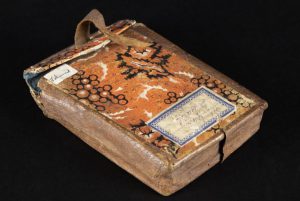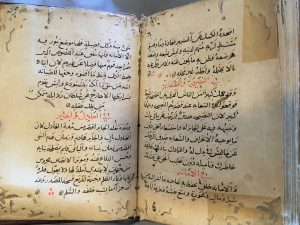About this manuscript
The Mukhtaṣar fī’l-fiqh has long been the most authoritative abridgement of Maliki law in Islamic Africa. It starts with six chapters on religious law and continues with fiftyfive chapters on civil law, such as marriage and divorce, war, defamation, partnership, legacies, to name but a few. The text is very concise and therefore not always unambiguous. Nevertheless, the Mukhtaṣar has been the standard handbook for African judges since the 15th century.
This copy shows that it was both designed and used as a handbook. It is very small and easily fits in a pocket – the pocket of a qāḍī’s clothing, for instance. The index is given on the first leaves (f 1v and f 2r) in a tabular format, with each chapter written at an oblique angle in each cell - a popular format for lists in manuscripts produced throughout the Islamic world. But since this book was so easy to use, and since this particular copy evidently was so frequently consulted, marks and wear and tear are evident.
Consider the first folia of the codex, the pages most exposed to damage. We can see that the entire original first folium, containing the first part of the index, was lost. It was replaced on the verso side of a new page (f 1v), written with a slightly broader pen. On the recto side of this inserted page we find a poem on the value of the content of the Mukhtaṣar. But this too is only a fragment, the beginning of the poem was written on another page which has also been lost.

The cover of the codex is heavily worn. To protect the volume from too much touching and from cockroaches or even rodents, it was kept in this satchel made of leather with a pretty cotton lining. To protect it against smaller insects, an owner wrote the incantation yā kaykataj three times in red on the outer leaf of the book-block, f 143v. This page does not constitute the end of the book, but is seems that this was the last folium surviving when the words were written, in the hope of avoiding more damage.
On ff 142-143, the surviving last folios, an owner has written large words in very diluted ink. On f 142v we read بسم الله الرحمن, the text on ff. 143v is less clear; these notes also appear to have been added for protective intentions.
Apart from black and red ink, green and some yellow are used in this codex. The first part of the text (until f 46a), is completely vowelled with red ink, in accordance with a Maghribi tradition. Green is used to highlight the beginning of new sections (fuṣūl). Yellow is used once in a while to highlight a word.
Literature
About yā kaykataj: Adam Gacek, Arabic Manuscripts. A Vademecum for Readers. Brill, 2009. 137-138.
About coloured inks in West Africa (Nigeria): Michaelle Biddle, ‘Inks in the Islamic Manuscripts of Northern Nigeria – Old Recipes, Modern Analysis and Medicine’ Journal of Islamic Manuscripts 2 (2011), 1-35.
More about this manuscript: Lesson 8, Lecture marks.
Questions
-
From what sorts of damage has this codex suffered?

